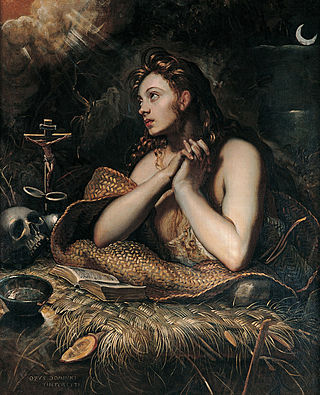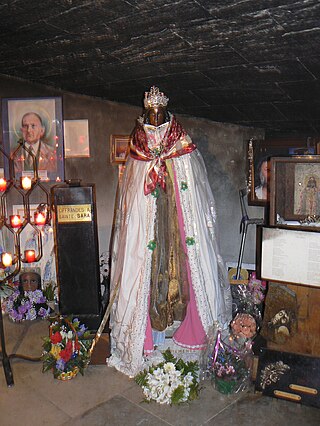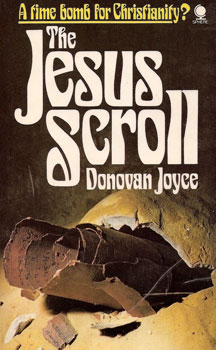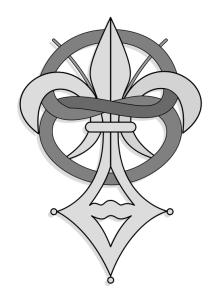
The Holy Grail is a treasure that serves as an important motif in Arthurian literature. Various traditions describe the Holy Grail as a cup, dish, or stone with miraculous healing powers, sometimes providing eternal youth or sustenance in infinite abundance, often guarded in the custody of the Fisher King and located in the hidden Grail castle. By analogy, any elusive object or goal of great significance may be perceived as a "holy grail" by those seeking such.

Mary Magdalene was a woman who, according to the four canonical gospels, traveled with Jesus as one of his followers and was a witness to his crucifixion and resurrection. She is mentioned by name twelve times in the canonical gospels, more than most of the apostles and more than any other woman in the gospels, other than Jesus's family. Mary's epithet Magdalene may be a toponymic surname, meaning that she came from the town of Magdala, a fishing town on the western shore of the Sea of Galilee in Roman Judea.
A Bible conspiracy theory is any conspiracy theory that posits that much of what is believed about the Bible is a deception created to suppress a secret or ancient truth. Some such theories claim that Jesus really had a wife and children, or that a group such as the Priory of Sion has secret information about the true descendants of Jesus; some claim that there was a secret movement to censor books that truly belonged in the Bible, etc.

Robert Langdon is a fictional character created by author Dan Brown for his Robert Langdon book series: Angels & Demons (2000), The Da Vinci Code (2003), The Lost Symbol (2009), Inferno (2013) and Origin (2017). He is a Harvard University professor of Religious Iconology and "symbology".

Laurence Gardner was a British author and lecturer. He wrote on various topics including historical-religious speculation such as the Jesus bloodline.

Saint Sarah, also known as Sara-la-Kâli, is the patron saint of the Romani people. The center of her veneration is Saintes-Maries-de-la-Mer, a place of pilgrimage for Roma in the Camargue, in Southern France. Legend identifies her as the servant of one of the Three Marys, with whom she is supposed to have arrived in the Camargue. Saint Sarah also shares her name with the Hindu goddess Kali who is a popular goddess in northern India from where the Romani people originate. The name "Sara" itself is seen in the appellation of Durga as Kali in the famed text Durgasaptashati.
Darrell L. Bock is an American evangelical New Testament scholar. He is executive director of Cultural Engagement at The Hendricks Center and Senior Research Professor of New Testament studies at Dallas Theological Seminary (DTS) in Dallas, Texas, United States. Bock received his PhD from Scotland's University of Aberdeen. His supervisor was I. Howard Marshall. Harold Hoehner was an influence in his NT development, as were Martin Hengel and Otto Betz as he was a Humboldt scholar at Tübingen University multiple years.
Michael Baigent was a New Zealand writer who published a number of popular works questioning traditional perceptions of history and the life of Jesus. He is known best as a co-author of the book The Holy Blood and the Holy Grail.
The Da Vinci Code, a popular suspense novel by Dan Brown, generated criticism and controversy after its publication in 2003. Many of the complaints centered on the book's speculations and misrepresentations of core aspects of Christianity and the history of the Catholic Church. Additional criticisms were directed toward the book's inaccurate descriptions of European art, history, architecture, and geography.
Richard Harris Leigh was a novelist and short story writer born in New Jersey, United States to a British father and an American mother, who spent most of his life in the UK. Leigh earned a BA from Tufts University, a master's degree from the University of Chicago, and a PhD from the State University of New York at Stony Brook.

The Da Vinci Code is a 2006 adventure puzzle video game developed by The Collective and published by 2K for PlayStation 2, Xbox and Microsoft Windows. Although the game was released on the same day that the film of the same name opened in theaters, it is based directly on the 2003 novel by Dan Brown rather than the film. As such, the characters in the game do not resemble nor sound like their filmic counterparts.

The Da Vinci Code is a 2003 mystery thriller novel by Dan Brown. It is Brown's second novel to include the character Robert Langdon: the first was his 2000 novel Angels & Demons. The Da Vinci Code follows symbologist Robert Langdon and cryptologist Sophie Neveu after a murder in the Louvre Museum in Paris causes them to become involved in a battle between the Priory of Sion and Opus Dei over the possibility of Jesus Christ and Mary Magdalene having had a child together.
The Jesus bloodline refers to the proposition that a lineal sequence of the historical Jesus has persisted, possibly to the present time. The claims frequently describe Jesus as having married, often to Mary Magdalene, and as having descendants living in Europe, especially France but also the UK. Differing and contradictory Jesus progeny scenarios, as well as more limited claims that Jesus married and had children, have been proposed in numerous modern books. Some such claims have suggested that Jesus survived the crucifixion and went to another location such as France, India or Japan.

The Jesus Scroll is a best-selling book first published in 1972 and written by Australian author Donovan Joyce. A forerunner to some of the ideas later investigated in The Da Vinci Code, Joyce's book made the claim that Jesus of Nazareth may have actually died aged 80 at Masada near the Dead Sea, site of the last stand made by Jewish zealot rebels against the Roman Empire, after the Fall of Jerusalem and the destruction of the Second Temple.

Graham Phillips is a British author. Phillips has a background working as a reporter for BBC radio, and he was the Founding Editor (1979) of Strange Phenomena magazine. He has made a number of controversial claims concerning the Arthurian legend, such as the discovery of the 'Hawkstone Grail', a small stone cup that he claims is the original Holy Grail; the identification of a Roman ruin as the "historical Camelot"; and the claim to have discovered King Arthur's grave. He has also investigated various biblical mysteries, again presenting some controversial theories, such as an alternative location for Mount Sinai at Petra in Jordan, an Egyptian staff in a British museum as the staff of Moses, and a grave on the British island of Anglesey as the tomb of the Virgin Mary.
The Woman with the Alabaster Jar: Mary Magdalene and the Holy Grail is a book written by Margaret Starbird in 1993, claiming Jesus Christ and Mary Magdalene were married, and that Mary Magdalene was the Holy Grail.

The Prieuré de Sion, translated as Priory of Sion, was a fraternal organization founded in France in 1956 by Pierre Plantard in his failed attempt to create a prestigious neo-chivalric order. In the 1960s, Plantard began claiming that his self-styled order was the latest front for a secret society founded by crusading knight Godfrey of Bouillon, on Mount Zion in the Kingdom of Jerusalem in 1099, under the guise of the historical monastic order of the Abbey of Our Lady of Mount Zion. As a framework for his grandiose assertion of being both the Great Monarch prophesied by Nostradamus and a Merovingian pretender, Plantard further claimed the Priory of Sion was engaged in a centuries-long benevolent conspiracy to install a secret bloodline of the Merovingian dynasty on the thrones of France and the rest of Europe. To Plantard's surprise, all of his claims were fused with the notion of a Jesus bloodline and popularised by the authors of the 1982 speculative nonfiction book The Holy Blood and the Holy Grail, whose conclusions would later be borrowed by Dan Brown for his 2003 mystery thriller novel The Da Vinci Code.

The Holy Blood and the Holy Grail is a book by Michael Baigent, Richard Leigh, and Henry Lincoln.
The Fifth Gospel, first published in Germany in 1993, is a novel by Philipp Vandenberg.
Mary Ann Beavis is a professor emerita, St. Thomas More College, the University of Saskatchewan. She co-founded the peer-reviewed academic journal, S/HE: An International Journal of Goddess Studies, together with Helen Hye-Sook Hwang in 2021.










